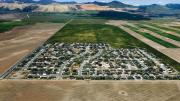A common way to dramatize climate change is to show before-and-after pictures: now you see the icebergs, now you don’t. “It seemed like there was more to it than that,” says Alex MacLean ’69, M.Arch. ’73. Photographs of vanishing glaciers show the effect but not the cause, he says, leaving out the “everyday way we live and the way we use and produce energy” (see, for example, “A Melting World,” May-June 2006, page 36). To him, refineries, interstate highways, and sprawling suburbs tell a larger story about how we use our resources and the consequences that follow. He chronicles our impact on the atmosphere from the atmosphere, taking pictures of the ground from high above as he crisscrosses the country in his plane.
MacLean’s seventh book, Over: The American Landscape at the Tipping Point (Abrams), collects hundreds of his aerial pictures. The book is divided into nine chapters, each on a different topic, such as energy or sprawl. He begins each chapter with a short essay on what the reader is about to see. “At first I turned my eyes away,” he writes in the introduction to his urbanism chapter, “hoping the messiness of what I was seeing would not affect my interpretation of natural beauty. Over time, however, I turned the focus of my camera on these more degraded areas with a vengeance, hoping that others might see the destructive process at work.” The book includes images of mansions outside Pittsburgh, decommissioned nuclear plants in Oregon, rows and rows of recreational vehicles in Arizona, seaside skyscrapers in Florida, and even Harvard’s own Jordan Field near the Charles River. Below each photograph, a caption explains its subject’s environmental significance. (The picture of Jordan Field shows its synthetic surface being watered, a prerequisite before field hockey matches; “a fine mist evaporates from this large sprinkler before it even reaches the ground, representing wasted water,” MacLean chides.)
Over pays particular attention to water use in America’s southwestern deserts. A grant from the Lincoln Institute of Land Policy, a research organization in Cambridge, helped fund years of observation in Arizona, New Mexico, and Nevada. MacLean flew above artificial lakes and gaudy casinos, one with fountains shooting thousands of gallons of water into the air. Neon-green golf courses, which also require an immense amount of water, dotted the brown landscape. “A lot of these photographs, I think, are almost metaphors or symbols for these larger ideas,” he says. “When you’re looking at using a limited resource for purposes of golf in the middle of the desert, it raises questions about how resources, finite resources, are used and who gets to use them.” (For more information, visit www.alexmaclean.com.)
MacLean traces his interest in environmental issues to his childhood home, an 11-acre “hobby farm” that his father, a researcher at the National Institutes of Health, had bought outside Washington, D.C. As an undergraduate, he took up photography; while at the Graduate School of Design, he learned to fly. “I was lucky because I had a friend who taught at a flight school that his uncle owned in Florida,” MacLean remembers. The school had a summer camp, and MacLean signed on as a counselor; during the next few months, he earned his license.
After completing his degree and traveling for a year, MacLean settled in Syracuse and worked at a landscape architecture office. He quickly decided he would rather spend time in the air. “Then it was just a matter of: how do you actually generate enough income to support flying and taking pictures?” He sold photographs to university slide libraries before branching out to jobs for architects and planners who needed a bird’s-eye view of their projects. Now he is based in the Boston area, with commercial jobs, stock photographs, and gallery prints each supplying a third of his income.
Far from distracting from his artistic pursuits, the jobs for architects and planners give MacLean the chance to hone his skills. “The commercial work is really like target practice,” he says. To get the picture his clients need, he has to consider a host of variables. Once he establishes what sort of lighting he wants (backlit or front?), he approaches from the appropriate angle. He then opens his window and holds the camera steady with both hands, controlling the plane only with the pedals at his feet. If he needs to shoot downward, he banks the plane to one side—but this maneuver complicates his shot, because banking makes the plane turn and sink. To compensate, MacLean sets up above and to the side of his target, then swoops across it. If he’s flying over a city, he also has to contend with air-traffic controllers and crowded airspace.
His commercial jobs are also chances to scout points of personal and artistic interest. While flying from New Mexico to Wyoming, he might cruise over Denver to look at new urban developments. Going up expecting to find something beautiful or meaningful enough to put into a book on every flight, MacLean says, would quickly frustrate him. Instead, he sits back and waits for something to catch his eye. “To an extent, it’s happenstance,” he says. “But that’s the nature of the art form.” He may not even know exactly what he’s seen until after he lands and reviews his pictures. “It seems like you’re actually drawn to the image, but you don’t fully understand it,” he says. “At the time, it’s more of an intuitive, subliminal thing.”
Even the suburbs and shopping malls have to hold some sort of attraction. “The images have to be alluring,” he says. “You have to bring the viewer into them, so they’ll look at them and think about what they’re actually looking at.”













